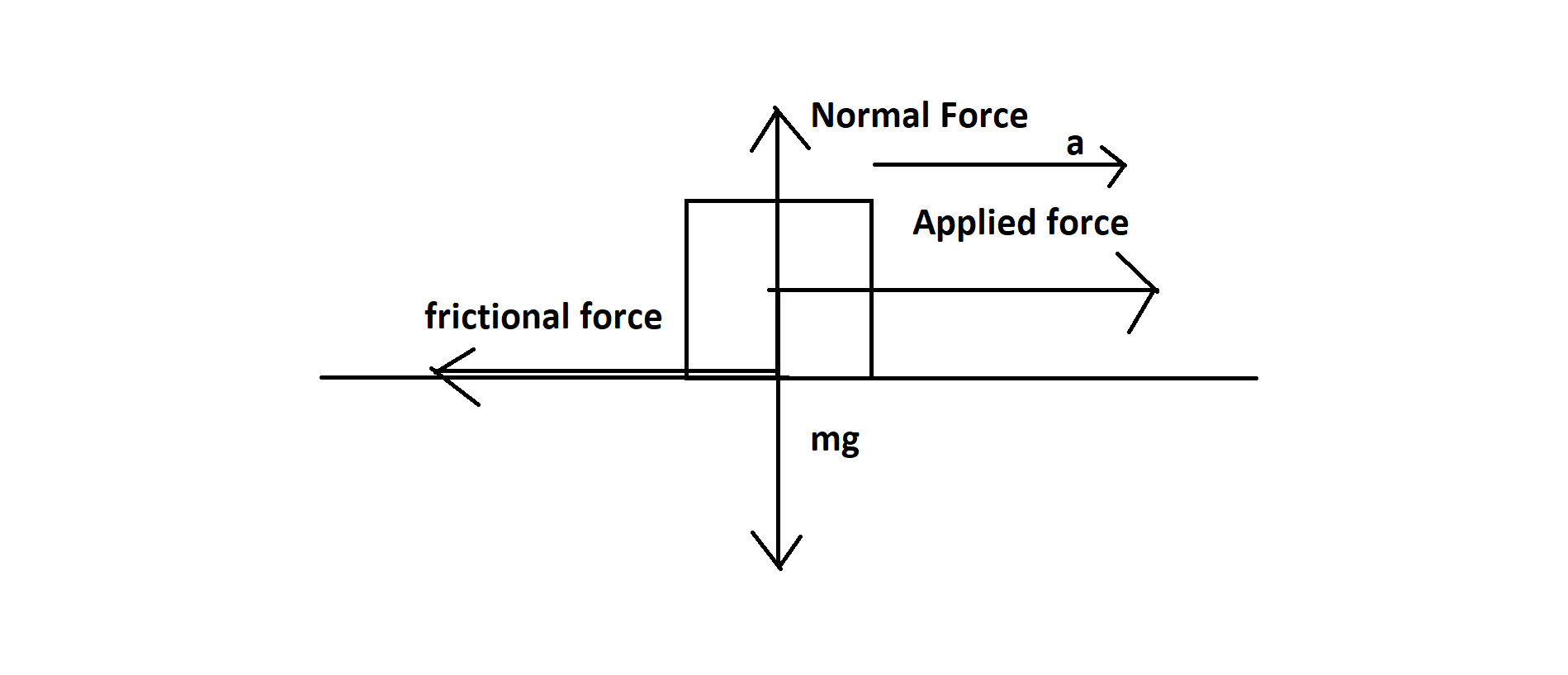
A body of 10 Kg is acted by a force of 129.4 N if \[g\;m/se{c^{2\;}}\]. The acceleration of the block is \[10\;m/{s^2}\]. What is the coefficient of kinetic friction?
A. 0.03
B. 0.01
C. 0.30
D. 0.25
Answer
219.6k+ views
Hint:The coefficient of kinetic friction is a measure of how much resistance there is to sliding motion between two surfaces. The kinetic friction coefficient is always smaller than or equal to the static friction coefficient. Create a free body diagram. Frictional force is given by $f = \mu N$ where N is the normal force and $\mu $coefficient of kinetic friction.
Complete answer:
First see a picture of the scenario. Let's draw a free body diagram.

Here we are considering a body of mass m moving with an acceleration and frictional force opposing its motion. friction is a force that resists the sliding of two surfaces against each other. The frictional force is proportional to the normal force, which is the force that is perpendicular to the surfaces. The coefficient of friction, $\mu $, determines how much friction there is between the two surfaces. We can define friction as $f = \mu N$ where N is the normal. Normal force is the force that a surface applies to an object that comes into contact with it. This force is perpendicular to the surface and is responsible for keeping objects in contact with each other. Here we see that normal force is balanced by the weight of the body. That means $N = mg$ . so, we can also write $f = \mu mg$ . Now we can write the equation as $F - \mu mg = ma$ Here F is applied force. Now let’s put the values on the equation.
$F - \mu mg = ma$
$\begin{gathered}
or,{\text{ }}129.4 - \mu 10 \times 9.8 = 10 \times 10 \\
or,29.4 = 98\mu \\
\end{gathered} $
$or,\mu = 0.3$
Coefficient of friction is 0.3. Hence option C is the correct option.
Therefore C is the right answer.
Note: A force called friction prevents two surfaces from sliding against one another. The normal force, or the force that is perpendicular to the surfaces, is directly proportional to the frictional force and mathematically given by $f = \mu N$.
Complete answer:
First see a picture of the scenario. Let's draw a free body diagram.

Here we are considering a body of mass m moving with an acceleration and frictional force opposing its motion. friction is a force that resists the sliding of two surfaces against each other. The frictional force is proportional to the normal force, which is the force that is perpendicular to the surfaces. The coefficient of friction, $\mu $, determines how much friction there is between the two surfaces. We can define friction as $f = \mu N$ where N is the normal. Normal force is the force that a surface applies to an object that comes into contact with it. This force is perpendicular to the surface and is responsible for keeping objects in contact with each other. Here we see that normal force is balanced by the weight of the body. That means $N = mg$ . so, we can also write $f = \mu mg$ . Now we can write the equation as $F - \mu mg = ma$ Here F is applied force. Now let’s put the values on the equation.
$F - \mu mg = ma$
$\begin{gathered}
or,{\text{ }}129.4 - \mu 10 \times 9.8 = 10 \times 10 \\
or,29.4 = 98\mu \\
\end{gathered} $
$or,\mu = 0.3$
Coefficient of friction is 0.3. Hence option C is the correct option.
Therefore C is the right answer.
Note: A force called friction prevents two surfaces from sliding against one another. The normal force, or the force that is perpendicular to the surfaces, is directly proportional to the frictional force and mathematically given by $f = \mu N$.
Recently Updated Pages
Electricity and Magnetism Explained: Key Concepts & Applications

JEE Energetics Important Concepts and Tips for Exam Preparation

JEE Isolation, Preparation and Properties of Non-metals Important Concepts and Tips for Exam Preparation

JEE Main 2021 July 25 Shift 1 Question Paper with Answer Key

JEE Main 2021 July 22 Shift 2 Question Paper with Answer Key

States of Matter Chapter For JEE Main Chemistry

Trending doubts
JEE Main 2026: Application Form Open, Exam Dates, Syllabus, Eligibility & Question Papers

Understanding Uniform Acceleration in Physics

Derivation of Equation of Trajectory Explained for Students

Hybridisation in Chemistry – Concept, Types & Applications

Understanding the Angle of Deviation in a Prism

Understanding Collisions: Types and Examples for Students

Other Pages
JEE Advanced Marks vs Ranks 2025: Understanding Category-wise Qualifying Marks and Previous Year Cut-offs

Units And Measurements Class 11 Physics Chapter 1 CBSE Notes - 2025-26

NCERT Solutions For Class 11 Physics Chapter 8 Mechanical Properties Of Solids

Motion in a Straight Line Class 11 Physics Chapter 2 CBSE Notes - 2025-26

NCERT Solutions for Class 11 Physics Chapter 7 Gravitation 2025-26

Mechanical Properties of Fluids Class 11 Physics Chapter 9 CBSE Notes - 2025-26




